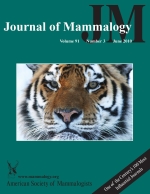Spacing patterns of large carnivores can affect demographic parameters of populations that, in turn, influence effective population size. As a result, better understanding of spatial structure can provide insight into effective conservation strategies. We examined home-range size, spacing characteristics, and changes in land tenure of radiocollared Amur tigers (Panthera tigris altaica) on the Sikhote-Alin Biosphere Zapovednik, Russia, from 1992 to 2006. We predicted that both sexes would maintain spatially exclusive home ranges and that subadult female tigers would tend toward philopatry and males would disperse. Home ranges (95% fixed kernel estimates; mean ± SD) of resident females (n = 20 home ranges of 14 females; 390 ± 136 km2) were significantly (P = 0.003) smaller than those of males (n = 6 home ranges of 5 males; 1,385 ± 539 km2). Geometric mean overlap between adjacent females (0.11 ± 0.11 SD) did not differ from that between adjacent males (0.14 ± 0.12). All radiocollared male cubs dispersed (n = 7), but only 2 of 6 female cubs dispersed from their natal home ranges. When human-caused mortality was low, female tigers survived long enough to divide their home range with their daughters, resulting in smaller home ranges and a higher density of breeding females. All females reproduced in these smaller territories, suggesting that they maintained home ranges that were larger than needed to meet reproductive demands. However, when human-caused mortality was high, females often did not survive long enough to bequeath home ranges to daughters, and population density was apparently maintained well below carrying capacity. The impacts of poaching appear to extend beyond the direct loss of individuals, and therefore reserves must be well protected if they are to serve as source populations for adjacent, unprotected areas of tiger habitat.
How to translate text using browser tools
16 June 2010
Spatial structure of Amur (Siberian) tigers (Panthera tigris altaica) on Sikhote-Alin Biosphere Zapovednik, Russia
John M. Goodrich,
Dale G. Miquelle,
Evgeny N. Smirnov,
Linda L. Kerley,
Howard B. Quigley,
Maurice G. Hornocker
ACCESS THE FULL ARTICLE

Journal of Mammalogy
Vol. 91 • No. 3
June 2010
Vol. 91 • No. 3
June 2010
Amur (Siberian) tiger
home-range overlap
Panthera tigris altaica
social structure
spacing patterns




